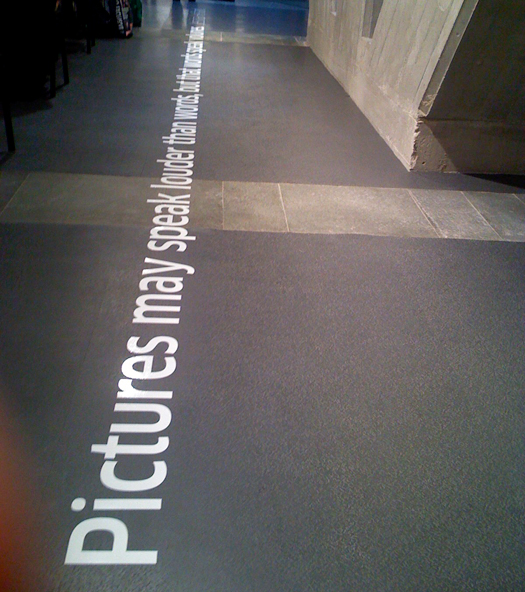
Installation from 2007 Design Bienniale, Slovenia.
Three years ago, William Drenttel and I had an exhibition of our work in conjunction with the 2007 Slovenia Design Biennial, which we were asked to jury. The exhibition's designers found an essay I'd written in 2000 — which had been commissioned on the occasion of the second edition of David Carson's book The End of Print — and which they reproduced, in part, with giant silkscreened letters on the floor of the gallery. The essay in its entirety appears below.
21 March 2000
Dear Fiona:
You are turning two in a few weeks and I think it’s high time you understood a thing or two about graphic design. After all, you are part of Generation ABC and what are ABCs, after all, but typography?
And what is typography, you ask?
A good question.
Typography is letters (and numbers) and why they look the way they do. Sometimes letters are BIG AND LOUD and sometimes letters are small and quiet. Typography can make words look good. It can also make words look bad. But the way they look — whether they’re pink or purple or big or small or quiet or noisy or happy or scary or funny or weird, well, that’s something that comes from typography.
Which is also called type.
Which is sometimes called print.
Which is a word that occasionally causes people to wrinkle up their noses and describe a time when it was customary to wear burlap shoes and sit hunched over, by candlelight, scratching painstakingly written messages to one’s friends and neighbors using quill pens. This really happened, back in ancient times. Like back when there were mummies and dinosaurs. Before television. Like when Daddy was little.
Printing is what you do when you write letters one at a time, as opposed to script, which is when you write letters so-that-they-connect-to-each-other-like-this. Printing is also used to describe what happens when machines (called presses) get ahold of all those words, all that typography and actually press the letters, together, onto paper.
Paper is a word that occasionally causes people to wrinkle up their noses and describe a time when it was customary to wear burlap shoes and sit hunched over, by candlelight, scratching painstakingly written messages to one’s friends and neighbors using quill pens. This really happened, back in ancient times. Like back when there were word processors and eight-track tapes. Before computers. Like when Mommy was little.
Now here’s the really confusing part. A lot of people say print is dead. Flat and not moving. Dead, like when we drive down our road and see a rabbit or a woodchuck that didn’t make it across in time? The whole concept of roadkill is something I had hoped to put off for a few years, but I think it’s important for us to get clear about one thing. Print isn’t dead, sweetheart. It’s just sleeping.
So as you begin to learn your ABCs, remember that your mind is like a giant alarm clock that wakes those letters up so that they spell something, so that they mean something, whether they’re on TV or in a book or scratched on the side of a wall somewhere. And while you’re at it, remember that S isn’t the same as 5 and I isn’t the same as 1. Remember that 1 L0V3 U isn’t the same as I LOVE YOU even though it looks cool. Remember that anything that looks cool probably won’t look cool for very long. Remember that very long means, well, probably about a day-and-a-half. Remember that pictures may speak louder than words, but that words speak volumes. Remember that sometimes typography can help you understand something or react to something or feel a certain way faster, but that it probably won’t help resolve conflicts between embittered nations or advance your capacity for reason or prevent you from getting bee stings or tick bites or chicken pox. Remember that spelling mistakes are celebrated in email but not tolerated in literature. Remember that literature is made up of stories that are what they are because someone wrote them down, letter by letter, word by word, intending for them to be read and remembered and retold for years and years and years to come. Remember that this is why your father and I want you to learn your ABCs, in the order in which they were intended to be learned, even though you can and will, mix up the magnets on the refrigerator to proudly spell words like hrldgsno and wsigefoo and pstwe1202ge. Someday when you read the work of Gertrude Stein or look at the work of David Carson you will make sense of such verbal and visual and perceptual aberrations, but until then, my sweet girl, remember that your ABCs are what helps you to read, and reading is what opens up your mind so that you can learn about anything you want. Turtles. Communism. Particle physics. Reading feeds your brain and helps your mind to grow. So today’s Goodnight Moon is tomorrow’s Charlotte’s Web is next year’s Elmer and the Dragon and before you know it you’ll be reading Thomas Hardy and Thomas Mann and A. S. Byatt and V. S. Naipaul, just as your parents did and our parents did and with any luck, your children will. And even though we read them printed on paper and you will very likely read them emblazoned on a screen, do you know what, Fiona? It doesn’t matter, because no matter what the typography does (or doesn’t do), and no matter what print is (or isn’t), words are just ideas waiting to be read. And reading will never die. Reading is your ticket to the world.
